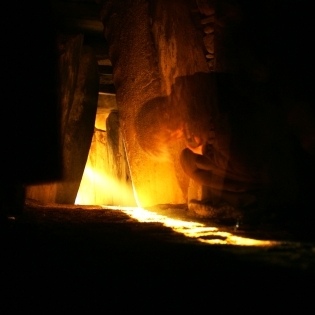 Nut grafs or otherwise relevant excerpts from entries which appeared last year at this time.
Nut grafs or otherwise relevant excerpts from entries which appeared last year at this time.
•
•
•
•
•
•
•
•
2010
I might never have figured out what was wrong if my husband hadn’t decided to replace our old alarm clock with something more up to date. The new clock, which he wrapped and put under the Christmas tree as a gift to ourselves, has both a pleasant chime and an assortment of nature sounds. Now I can fall asleep to the sound of birds calling in a rainforest or frogs warbling in a bayou, rather than always having my bedroom invaded by the rush of highway traffic. Although I wouldn’t have expected such a small thing to make so much difference, I’ve found that my perception of time has shifted noticeably in just the past week. Time seems to be moving more slowly and in a more comfortable and familiar pattern.
The patterns we’re exploring are in a group of people with two cerebral hemispheres that same size, people not finding conventional jokes and humor amusing, jokes that have to do with the integration or relationship of two different meanings.
I’ve had more than one close friend with Asperger’s in my life. We all choose friends that share our sense of humor. Consider that we are all conducting unconscious evaluations of each other’s brain structures, estimating hormonal constellations and social structure proclivity by what we find funny. Perhaps humor is an extremely refined diagnostic tool used to determine those we can feel close to and who would make complementary mates.
I believe that by studying humor we learn about nuances of being human. Different kinds of humor will associate with different degrees of cerebral lateralization. I have proposed that lateralization is associated with social structure, handedness and developmental stages. I’m also thinking that what we find funny provides a window into who we are.
Laugher may not only be the best medicine. Laughter might be useful in diagnosing the human condition. Laughter may offer insight into the nature of what caused our dis-ease.
• Ouroboros, Autism and Future Past
This is another suggestion of the ouroboros, the snake with her tail within her mouth, a thesis that suggests that aboriginal child rearing practices may usefully inform a society with an increasing number of neotenous characteristics with matrifocal tendencies. This feels right to me. Just as the features of our infant forebears manifest in the contemporary features of our species, what we would call classic neoteny, there are possible signs that characteristics of our societal forebears, aboriginal matrifocal societies, are characteristics that may usefully inform the features of contemporary times.
According to this thesis, tattoos and piercings among our youth will likely lead to other aboriginal borrowings. I would watch for an increase in ritualized behaviors. Music has reflected aboriginal themes for decades. If our young mothers and fathers were to start changing the way they raise their children, how might conventional ancient practices be reflected in modern practice?
Connections between the past and present seem to be growing stronger. There may be a reason for this. Our future may be integrally tied to our ancient past.
The broad effect of this approach when practiced by enough people is to privilege one cognitive style above all others, and in a thousand small and large ways to disable and impair the otherwise able and unimpaired whose cognitive styles are not so honored. Collectively, this amounts to peeing on autistic peoples’ legs while telling us—and perhaps while believing—that it’s only raining.
Good intentions then, here as most everywhere else, are not enough and hardly an excuse. Until people understand this in regard to autism—including in regard to behavior that is consistent with autism, but lacks the official stamp of diagnosis—there’s no call to let anyone have the bad manners to behave as if the something that is wrong, is us.
Mark Stairwalt on 01/10/11 in Art/Play/Myth, featured | No Comments | Read More

